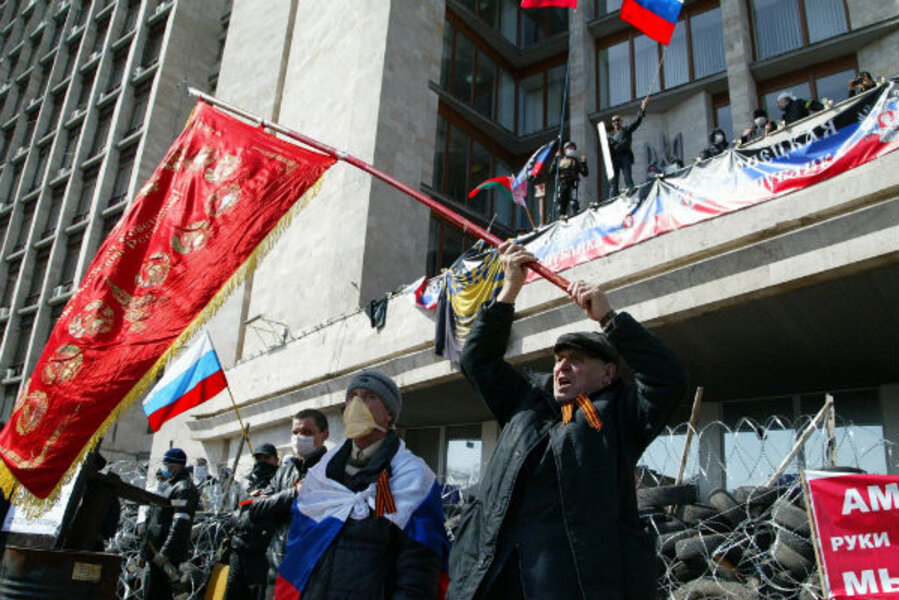Eastern Ukraine erupts. Should we be surprised?
Loading...
| Donetsk, Ukraine
For many, the sudden seizure of buildings in Donetsk was as unexpected as the arrival of masked, armed soldiers in Crimea six weeks ago.
In eastern Ukraine, as in Crimea, a large percentage of the population is ethnically Russian. In many regions, such as Donetsk, Kharkiv, and Dnipropetrovsk, loyalties to Russia also run strong, and distrust of the new government in Kiev runs deep. And as in Crimea, many ethnic Russians voice fears – exaggerated or not – of discrimination at the hands of Ukrainian nationalists who helped topple the previous government. [Editor's note: The original version misstated the size of eastern Ukraine's ethnic Russian population.]
However, until this weekend, eastern Ukraine had appeared calm. Nobody had attempted a coup or uprising; no paramilitary soldiers patrolled the streets.
But while Sunday's separatist upheaval may have appeared spontaneous, its underlying forces had been building for some time. And tacit encouragement from Moscow, if not outright manipulation, helped to bring Donetsk and other cities to the boil.
Until this weekend, eastern Ukraine’s outward calm concealed growing polarization. Long before Sunday’s separatist demonstrations, local activists of the movement known as EuroMaidan, or Maidan for short, say they have been feeling intensifying hostility from pro-Russian neighbors.
EuroMaidan supporters who own businesses in Donetsk say that they have faced increased bureaucratic hassles in recent weeks, including fire code inspections, tax audits, and other administrative pressures. Many have started to carry guns in their cars; others are switching apartments for sleep on a regular basis. Activists are afraid to meet in person and instead hold online voice discussions using virtual private networks to try to evade Russian surveillance.
“Only idiots aren’t afraid these days,” says one activist who asked not to be named, fearing Russian security agents.
The Moscow factor
For many analysts, it was only a matter of time before the “Crimean scenario” took place in eastern Ukraine.
“This was absolutely predictable from the very beginning,” says Alexei Kolomiyets of Kiev’s independent Institute of Euro-Atlantic Integration. “From the moment events began happening in Crimea, this scenario [of separatist protests] was fully expected.”
Most agree with pro-Ukrainian activists on the ground that the uprising is orchestrated by Moscow in order to destabilize the country before the May 25 presidential elections. The estimated 40,000 Russian troops and heavy weaponry stationed just across the border – less than an hour’s drive from Donetsk center – is contributing.
“Russia is doing everything it can to make sure that [Ukraine] is splintered, not a unified, single bloc,” says Vadim Karasev, an analyst with the Institute for Global Strategies.
In its negotiations with the United States and the EU, Moscow has pushed the concept of radically decentralizing government power in Ukraine, to give its regions substantial autonomy from Kiev. Moscow’s goal here, says Mr. Karasev, is to create a sort of satellite region, something akin to the Warsaw Bloc during the Cold War, to protect its own borders.
“Russia doesn’t need the Donbass,” he says, referring to the larger geographic region that includes Donetsk. “Russia needs a federalized system that it can manipulate, with its own policies.”
Observers disagree whether Russia does in fact plan to invade, or is merely using the presence of troops as a threat to influence negotiations. But if a military incursion is in the cards, Russia may be waiting for events to reach a threshold like in Crimea where intervention will be justified.
“I believe there is an intention to invade,” says Vera Nanivska, who heads the International Center for Policy Studies in Kiev. “They have to occupy these official buildings, hold these referendums, and carry out this procedure exactly as they did in Crimea. And then Russia will be here.”





